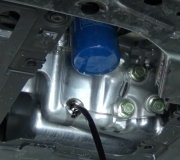KH, thanks for the info and congratulations on a great and useful site!
While putting new shocks on it today, I tugged around on the passenger side upper control arm bushings as well. Again, rear one seemingly doesn't show any movement to the naked eye, while the front one will move the same amount as the one on the driver's side. So, based on that quasi-logic, I guess they're both good. I had thought from previous experience (a high school job at Roy's Texaco garage a LONG time ago) that there should be zero movement in them. Must be confusing them with the ball joints. Speaking of which, I can't really get a pry bar in between the UCA/LCA and the knuckle to try to find movement in them. Is there another way to see if they are bad short of taking the knuckle off and seeing if they turn or are loose?
Clunking is only on accel or decel. Used to be one "clunk", now maybe I get a quick double "clunk". While having the wheel off today, I pulled around on the passenger-side half shaft and felt what I thought was radial looseness in it. It will telescope axially about 1/8"+. Normal, no?
Funny thing is, CV Joint doesn't bind or feel tight when rotating the hub while the wheel is turned fully left or right. Again, past experience (I thought!) Told me that I would feel a "bind" in it if CV joint was bad.
Thanks,
Elliott
Sunday, September 28th, 2008 AT 10:47 PM



